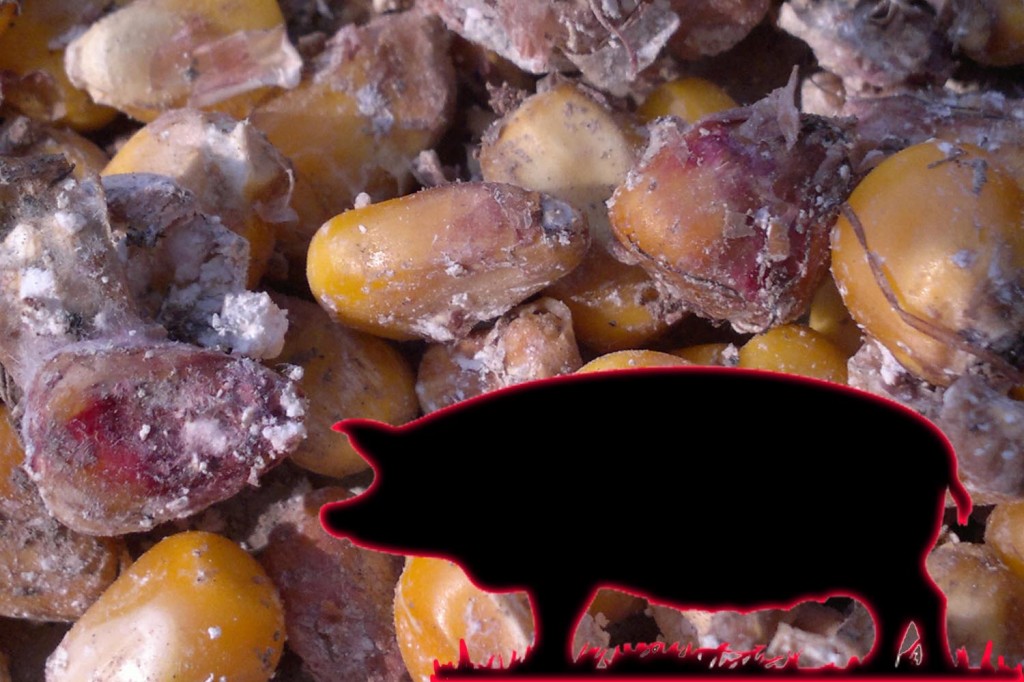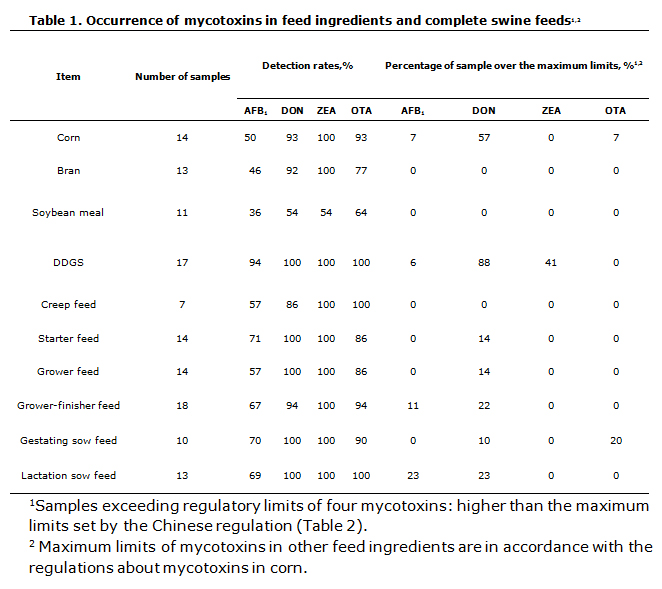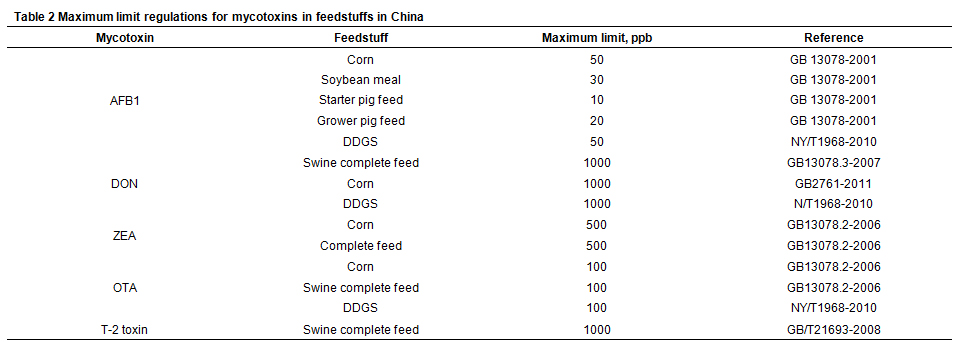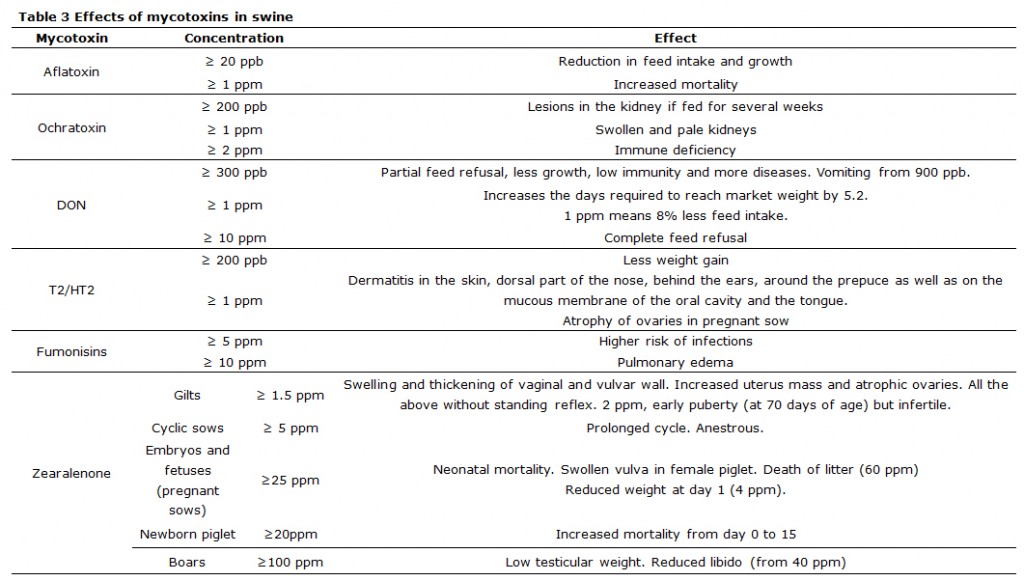25 Mar Safe levels of mycotoxins in swine feed

Understanding the contamination by mycotoxins is key to prevent their negative effects
Mycotoxins are secondary metabolites produced by fungi when they grow on agricultural products before or after harvest, during transportation or storage.
Mycotoxins pose a severe threat to humans and as well as causing huge economic losses in the feed and food industries. These toxic substances are known to be either carcinogenic (e.g. aflatoxin B1,ochratoxin A, fumonisin B1), oestrogenic (zearalenone), neurotoxic (fumonisin B1), nephrotoxic (ochratoxin), toxic to epidermis(trichothecenes) or immuno-suppressive (aflatoxin B1, ochratoxin A and T-2 toxin).
Pigs are particularly susceptible to mycotoxins, suffering a variety of chronic or acute syndromes depending on the amount of contaminants they consume.
Occurrence of mycotoxins in China
One of the most interesting scientific research about mycotoxin occurrence in China is published in the article “Occurrence of mycotoxins in feed ingredients and complete feeds obtained from the Beijing region of China”, written by Li et al, published in the Journal of Animal Science and Biotechnology 2014, 5:37.
The report is based on 131 samples including 55 feed ingredients and 76 complete swine feeds.
Corn
The occurrence of mycotoxin contamination in corn is summarized in Table 1. The results show that corn is frequently contaminated by AFB1,DON and OTA and that 57% of the samples contaminated with DON are above the maximum limits set by the Chinese regulation.
DDGS
The occurrence of mycotoxin contamination with DDGS is summarized in Table 1. The levels of DON and ZEA are particulary high. About 29% of the DDGS samples used in this study were contaminated with DON and ZEA at levels above 1 ppm and 500 ppb , respectively, which exceeds Chinese regulatory limits for feed stuffs.
Complete feeds
The occurrence of mycotoxins in complete swine feed is summarized in Table 1.
The percentage of grower-finisher pig feed and lactating sow feed contaminated with AFB1 above regulatory limits was 11 and 23% respectively .
The occurrence of DON was also very worrying. The percentage of samples with DON exceeding regulatory limits ranged from 14 to 23% in starter, grower, finisher, gestating sows and lactating sows stages.
During last year, our lab analyzed feed samples submited by our customers. While 100% of the samples were positive to DON, the percentage of samples with DON concentations exceeding regulatory limits was 77%.
In the study, the levels of ZEA and OTA do not exceed regulatory limits. This does not mean we could not see any clinical effects in the pigs caused by these mycotoxins. as there may well be chronic accumulated effects if the animals have eaten contaminated feed for long periods of time.
In contrast, AFB1 and DON are found in a high percentage of feed samples in concentrations that exceeded regulatory limits, which could have clinical effects. The fact that AFB1 was found at concentrations exceeding regulations in feeds for lactating sows could be of importance in terms of animal’s health. Indeed, it could lead to the excretion of AFM1 through the sow’s milk and to an exposure of piglets to that toxin. Young animals are more sensitive to aflatoxins than adults. While for DON, concentrations as low as 1 ppm may cause loss of appetite, vomiting, low feed efficiency and a reduction in body weight gain.
Therefore, the high incidence of mycotoxins found in complete feed samples obtained from swine farms highlights the need for surveillance and prevention of mycotoxin risks.

Extracted from “Occurrence of mycotoxins in feed ingredients and complete feeds obtained from the Beijing region of China”, written by Li et al, published in the Journal of Animal Science and Biotechnology 2014, 5:37.
Legal mycotoxin contamination limits for swine feedstuffs in China

Extracted from “Occurrence of mycotoxins in feed ingredients and complete feeds obtained from the Beijing region of China”, written by Li et al, published in the Journal of Animal Science and Biotechnology 2014, 5:37.
Maximum advisable level of each mycotoxin in swine feed
Sometimes the level of each mycotoxin found in the analysis is below the maximum level allowed by legislation, but still there are clinical effects in the farm or a drop on the productivity is noticed. This phenomenon happens because there are synergistic effects among different mycotoxins or because the contaminated feed is given for long periods of time and the mycotoxins accumulate in the animal.
The following is a table describing the effects of each mycotoxin at the corresponding concentration. Levels below the threshold should be considered safe.

Mycotoxin analysis service offered by PlusVet Animal Health
Pigs are among the most sensitive species to mycotoxins.
If you encounter medium or high levels of mycotoxin contamination, the clinical signs and the effects on the productivity may be higher than the individual toxicity of each mycotoxin. Therefore, the result of the mycotoxin analysis is not easy to decipher.
To make the job of our customers easier,we offer a mycotoxin analysis service for feeds and raw materials and we help to determine if the levels are dangerous or not for the animals.
You can learn more about our services here.
Ms. SunYing, Head of Quality Assurance
Products of choice
PlusBind© is a mixture of carefully selected silicates intended for the prevention of diseases and productivity losses related to the presence of all types of mycotoxins. It is indicated in poultry, pigs, aquaculture and ruminants.
The silicates present in PlusBind© have a highly expandable molecular structure. This characteristic gives the product a wide surface available for the adsorption of mycotoxins and therefore allows a high effectiveness at lower doses (0.5-1 kg per ton of feed).
PlusBind Bio© is a mixture of carefully selected silicates intended for the prevention of diseases and productivity losses related to the presence of all types of mycotoxins. It also contains plant extracts with prebiotic effect.
It is indicated in poultry, pigs and aquaculture.
The silicates present in PlusBind Bio© have a highly expandable molecular structure. This characteristic gives the product a wide surface available for the adsorption of mycotoxins and therefore allows a high effectiveness at lower doses (0.5-1 kg per ton of feed).

Certain health statements may not be applicable in your region.

